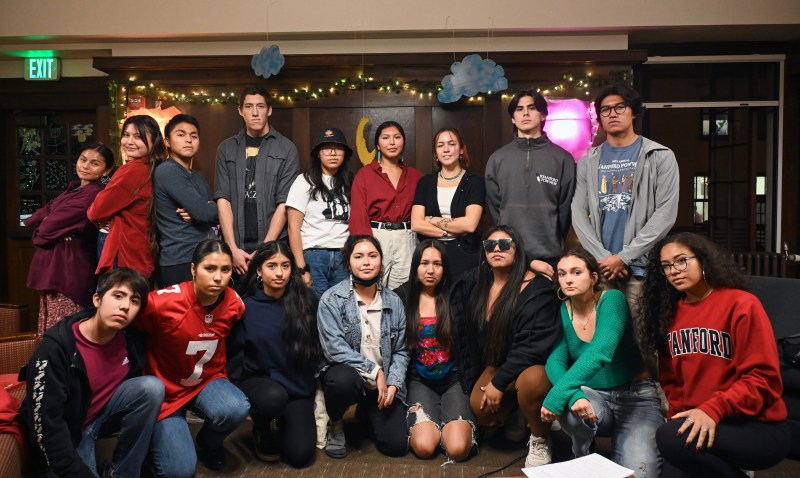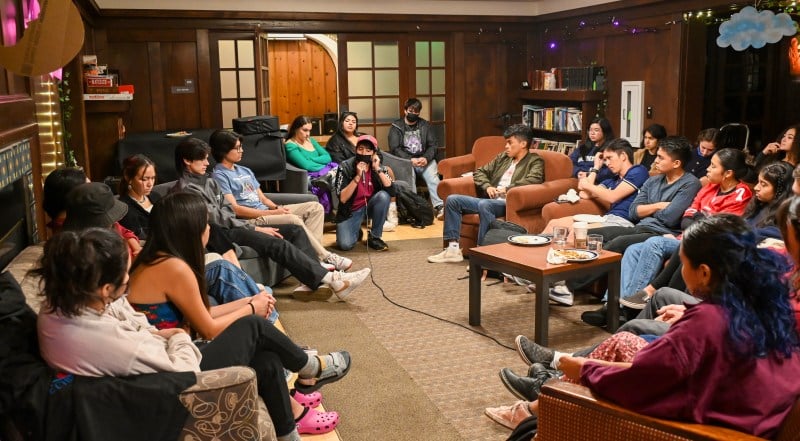A roundtable of approximately 20 indigenous students shared the history of Stanford’s participation in colonialism and called on non-native individuals to support indigenous voices during the Land Back Teach-in Nov. 2. Kairos, a cooperative row house, hosted the teach-in for a second year to celebrate and educate on indigenous culture on campus.
The panelists shared the nuanced meaning of “Land Back,” a generational movement with a long legacy of organizing and sacrifice to get Indigenous lands back into Indigenous hands.
Toli Tate ’23, an RA at Kairos who was one of the lead organizers, began the discussion by speaking about the complexities of Land Back. In learning Navajo with her father, she discovered that the language does not have a term for Land Back due to the tribe’s cultural relationship with the land, which is not centered in private property or ownership.
“I think globally, [Land Back is] just about returning relationships, stewardship and recognition of indigenous people to the lands, and recognizing that historical ties and relationships, that indigenous people know the lands because we’ve been… interacting with it for so long,” Tate said.
John Lowndes ’25 echoed this sentiment, discussing the importance of land to indigenous tribes. “Everything is centered around land. In my people, we still live off the land, we fish. All our language is built around our land, our culture, our customs, our regalia, and what comes from the land and without the land I think all of these things are infinitely harder,” Lowndes said.
The group also discussed Stanford’s historical participation in indigenous genocide in California. Leland Stanford raised quasi-military campaigns against Natives during California’s genocidal “War of Extermination,” which led California’s Native population to plummet from 350,000 to 18,000 people.
Lowndes said this history was important context to Stanford’s land acknowledgment and the “irony” of bearing Leland Stanford’s name.
“Stanford words are kind of empty without any sort of acknowledgement of their role in the California genocide and their role of why indigenous people kind of face the fate they do today,” Lowndes said.
Panelists discussed how many students in the recent past had to fight against Stanford’s honorarium for colonists and disrespect toward indigenous culture, including changes such as renaming Serra Mall into Jane Stanford Way and removing the Native mascot.
Lowndes also said that Stanford’s Powwow — an annual festival centering indigenous identity and culture on Mother’s Day weekend — does not receive the same treatment as other events on campus. Money that is budgeted into the event goes back to the University, as they need to rent out space for the event, Lowndes said.

The group also discussed cultural appropriation and microaggressions, including their Halloween experiences when they saw native culture used as costumes and conversations when their Native heritage was put in terms of blood quantum. With the need to solve issues like these, Land Back “is much more than literally [returning] the land,” according to Tate.
Tate said she now values “Land Back” signs on Stanford’s campus, including at Kairos, which has one on the front porch. When she first moved to Kairos, she appreciated the sign but also worried that it took away the meaning from a radical phrase. However, when she saw people passing by who took notice of the sign, she said she recognized its power.
“I had the perfect view of all the people from this rich neighborhood next to us that would like to walk by the house and see the banner and look at it and get annoyed and be like, ‘what’s that about? Like, why are these kids doing this?’” Tate said. “But it made me so happy because I was like ‘We’re disrupting this space.’”
Student activists also called for community members to educate themselves on current legal battles, such as the current Supreme Court case on the Indian Child Welfare Act (ICWA) and legislation on “Indian” Mascots, and support environmental activism on campus.
They also specifically called on non-native Stanford students to use their privilege to support the causes of Indigenous students through measures including departmentalizing Comparative Studies in Race and Ethnicity. As a starting point, Tate encouraged students to truly listen and engage with land acknowledgments to ensure they are not simply performative.
“You learn a lot when you start looking around,” Tate said. “What are the issues going on around in the bay area right now? What are resources I can point people to? And what are the things that tribes are doing that are extremely meaningful… so that I’m not just telling people about how sad the history is.”
